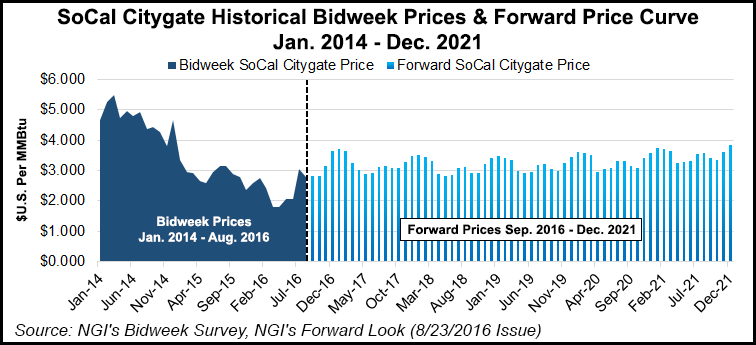NGI The Weekly Gas Market Report | Infrastructure | NGI All News Access
California Outlines Winter Reliability Plan With Gas Storage Limits
California’s major energy agencies on Monday released a draft winter reliability plan to respond to the continuing natural gas storage limitations in the state. The plan assumes that “normal winter demand” can be met by the three other storage facilities in the region.

The plan is designated to help preserve reliability of natural gas and electricity service in the region in light of the limits placed on Southern California Gas Co.’s (SoCalGas) Aliso Canyon underground storage facility, the state’s largest (see Daily GPI, Aug. 17).
This latest plan concludes that “while risks to energy infrastructure still exist due to the uncertainty of weather and system conditions without Aliso Canyon, conservation and other mitigation measures will help to meet the energy needs of Southern California this winter,” a spokesperson for the cooperating agencies said.
The California Energy Commission (CEC), California Public Utilities Commission (CPUC), California Independent System Operator (CAISO), and Los Angeles Department of Water and Power (LADWP) jointly authored the plan and will participate in a workshop on Friday, along with representatives from Walker & Associates and Los Alamos National Laboratory. The CEC is hosting the meeting.
A 40-page technical report developed by the staffs of the CEC, CPUC, CAISO, LADWP and SoCalGas makes the case that the winter plan can reduce risk but not eliminate it. Basing its assessment on a one-in-10-year cold winter, the paper said the 10-year standard of meeting both core and noncore customer needs “cannot be met without withdrawing supply from Aliso Canyon during the coming winter months.”
The assessment said that because of the summer reliability plan’s success so far, no gas has been withdrawn from Aliso Canyon.
Staff members from the respective organizations will present parts of the draft plan aimed at winter 2016-2017. Separate panels of utility and large-scale energy user representatives also will provide perspectives on the draft plan on Friday.
In releasing the draft plan, officials at the energy organizations commended Southern California residents for their response so far in calls for conservation, and they urged them to continue their efforts from this summer into the winter.
Noting that the 86 Bcf capacity, 3,600-acre Aliso Canyon facility has never before been constrained as it is now, state officials said that the CPUC had required the current 15 Bcf of working capacity at Aliso for use only during “periods of peak demand to avoid energy interruptions.”
“The challenges of serving normal winter average demand without using Aliso Canyon can be resolved by increasing withdrawals from other natural gas fields,” the draft plan concluded. “For the coldest days, while risk exists, demand can be met by withdrawals from other fields and replacement of lost generation from other resources.”
In addition to the summer mitigation measures still in place (see Daily GPI, May 19), the winter plan includes:
The assessment concluded that for the gas system to maintain reliability under current conditions without Aliso Canyon, supportable gas demand is estimated at 4.7 Bcf/d, compared with the 5.2 Bcf/d demand forecast established by the one-in-10 cold day design standard.
“To the extent that the core and noncore gas demand totals reach or exceed the supportable demand, SoCalGas has the authority to curtail noncore customers to maintain gas system reliability,” according to the technical assessment.
Based on peak winter gas demand conditions, the technical assessment said that average daily supplies coming into the SoCalGas system need to stay above 4.1 Bcf/d this winter.
© 2024 Natural Gas Intelligence. All rights reserved.
ISSN © 1532-1231 | ISSN © 2577-9877 | ISSN © 1532-1266 |
